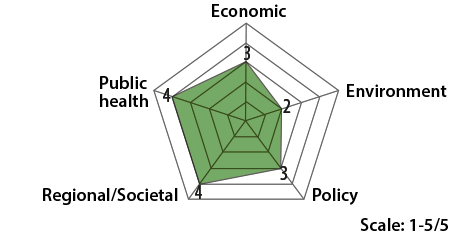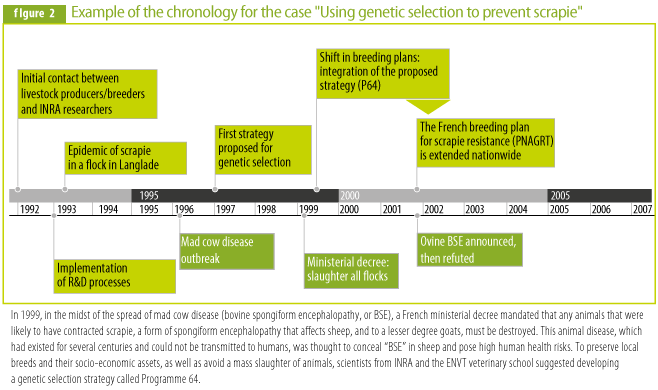Society and regional strategies 5 min
Combining chronology, a master plan and a radar
How can the socio-economic impacts of INRA’s research be measured? And how can the mechanisms used to generate impacts be improved? The ASIRPA team designed a method based on three tools to standardise the analysis of thirty case studies.
Published on 20 July 2015

Standardisation has two aims: to enable comparison of case studies and draw generic lessons from them to improve the mechanisms that generate impacts. To create the methodology, the ASIRPA team analysed 30 case studies selected for their variety and the importance of their impacts: 14 were carried out during the trial phase and 16 were carried out as part of the evaluation process for several INRA research divisions.
One method, three tools
The standardisation method created using this analysis is based on the combined use of three analytic tools: chronology, impact pathways and impact vectors.
Chronology: from research to impacts
Chronology is used to identify the start and end of a case and determine the important events that took place over that time. The chief aim is to identify the various stakeholders – whether from INRA or others – who are involved and to determine the skills and resources employed. The chronology also highlights the events in which INRA was directly involved, such as for patent filings, disseminating a methodology or changing its level of involvement.
In the case of the Bisphenol A research, the chronology mentions that the research results showed the impact of BPA on the gut barrier. It also notes the Institute’s involvement in the draft law to prohibit its use in all food packaging (policy and public health impacts). Lastly, the chronology lists the contextual events that occurred during the period and which of them changed the impact pathway. One example of this would be the outbreak of mad cow disease in the scrapie case study (see inset). To make reading the chronology easier, it is presented as a timeline chart.
Impact pathway: a short history of a case
A case study’s impacts and related events are presented in chart form. The objective is to view INRA’s specific contribution to the impacts from those of the other involved stakeholders as well as identify the critical situations and key moments throughout the process. In the case of Naskéo, which was discussed on page 1, the impact pathway would note the start-up’s creation in addition to the impacts for the company, for INRA, and more broadly speaking, for the environment. The impact pathway is divided into five categories by chronological order: Inputs, Outputs, Intermediaries, Level 1 Impacts and Level 2 Impacts.
- Inputs are all the investments (skills, infrastructures, financing, partnerships, etc.) that INRA and the other stakeholders used to produce the technical and scientific knowledge. Analysing the inputs is vital to determine the share of INRA’s and the other stakeholders’ contributions in generating impacts.
- Outputs represent the research products: publications, patent filings, databases, technical products, expertise, strategies, etc.
- Intermediaries are all organisations or resources that contributed to creating Outputs through their use or various investments. They include professional organisations, staff, consulting firms, technical resources or media.
- Level 1 Impacts show the initial beneficiaries of an Output to which INRA contributed. This might be, for example, a start-up that was created to exploit a research product or simply a producer of an innovation.
- Level 2 Impacts pertain to the generalised adoption of the Output. They reflect policy, economic or environmental changes and are the culmination of a case.
Impact vector: a radar of impact intensity
19.4 years between when research begins and achieving impacts
Using a radar chart, the impact vector shows the range and diversity of the impacts in the five areas selected by the ASIRPA team, i.e.,economic, environmental, policy, public health and regional/societal. The importance of each impact area is ranked, from 1 (very low) to 5 (very strong). The rankings were determined by comparing all of the cases studied in the ASPIRA project after all available information was analysed and following interviews with the different stakeholders involved at the various stages of the impact pathway. These rankings are provided in a table with a brief description of each impact.
A valuable study
When used together, these three tools make it possible to not only identify the various stakeholders involved in generating impacts, but to also measure their contributions. The analysis of impact pathways demonstrates that INRA contributes at every stage, from Inputs through Level 2 Impacts. The analysis is all the more valuable in that it evaluates the knowledge, skills and infrastructures accumulated over a long period of time. Analysing case studies also highlights the long duration of impact pathways: on average, there are 19.4 years between the start of the case and the production of Level 2 Impacts, of which 14 years are dedicated to research alone. Another lesson is that research generates impacts that frequently stretch across disciplines. The case study on tartaric stabilisation of wine through electrodialysis offers an example of this. The method designed to prevent sediment relies on technologies and research from the fields of oenology, mathematics and the dairy industry. The analysis also showed that strong impacts often occurred when INRA contributed at each stage of the impact pathway.
Genetic selection to prevent scrapie
The analysis of different impact vectors shows the multidimensional nature of most case studies, which reflects INRA’s diverse objectives. However, the case of using genetic selection to prevent scrapie is remarkable for two reasons. First, the intensity of the generated impacts is medium to strong in four of the five areas; second, INRA made significant contributions to each of them.

| Impact area | Importance | |
|---|---|---|
| Economic | 3/5 | Sustained economic competitiveness for producers by avoiding the slaughter of flocks. Strong economic impact for the specific local region but low at the national level. |
| Environmental | 2/5 | Maintenance of landscapes and ecosystems by preserving and adapting agropastoral farming practices associated with the Manech red head sheep breed to fit local needs. |
| Policy | 3/5 | Reassurance for public policymakers: research by INRA and the National Veterinary College of Toulouse (ENVT) offered solutions during a crisis situation that were bolstered by both institutions’ scientific credibility. |
| Regional/Societal | 4/5 | Sustained economic activity and social coherence in a difficult region and avoidance of losses (animals destroyed, employment): €52.6 million between 2000 and 2020. |
| Public health | 4/5 | More rams for artificial insemination carrying both alleles with resistance to scrapie in the PrP gene and diminished sensitivity alleles in all French sheep flocks. |
The case of scrapie
In 1999, in the midst of the spread of mad cow disease (bovine spongiform encephalopathy, or BSE), a French ministerial decree mandated that any animals that were likely to have contracted scrapie, a form of spongiform encephalopathy that affects sheep, and to a lesser degree goats, must be destroyed. This animal disease, which had existed for several centuries and could not betransmitted to humans, was thought to conceal “BSE” in sheep and pose high human health risks.
To preserve local breeds and their socio-economic assets, as well as avoid a mass slaughter of animals, scientists from INRA and the ENVT veterinary school suggested developing a genetic selection strategy called Programme 64. Of the thirty case studies analysed for the ASIRPA project, the example of using genetic selection to prevent scrapie showed the influence that investments, infrastructures and long-term research could have in generating impacts. The chronological chart lists the major events that occurred during the initial research efforts related to scrapie in 1992 through the Level 2 Impacts, whereby a solution developed to meet a local need was extended to all of France.

